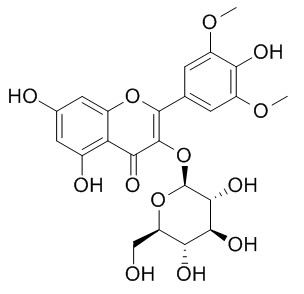Syringetin-3-O-glucoside
Reference standards.
Inquire / Order:
manager@chemfaces.com
Technical Inquiries:
service@chemfaces.com
Tel:
+86-27-84237783
Fax:
+86-27-84254680
Address:
1 Building, No. 83, CheCheng Rd., Wuhan Economic and Technological Development Zone, Wuhan, Hubei 430056, PRC
Providing storage is as stated on the product vial and the vial is kept tightly sealed, the product can be stored for up to
24 months(2-8C).
Wherever possible, you should prepare and use solutions on the same day. However, if you need to make up stock solutions in advance, we recommend that you store the solution as aliquots in tightly sealed vials at -20C. Generally, these will be useable for up to two weeks. Before use, and prior to opening the vial we recommend that you allow your product to equilibrate to room temperature for at least 1 hour.
Need more advice on solubility, usage and handling? Please email to: service@chemfaces.com
The packaging of the product may have turned upside down during transportation, resulting in the natural compounds adhering to the neck or cap of the vial. take the vial out of its packaging and gently shake to let the compounds fall to the bottom of the vial. for liquid products, centrifuge at 200-500 RPM to gather the liquid at the bottom of the vial. try to avoid loss or contamination during handling.
Appl. Sci. 2021, 11(10),4666.
Industrial Crops and Products2018, 353-362
Faculty of Chem. & Nat. Resource Eng.2014, 62
Molecules2022, 27(3),1140.
Chin. Med.J.Res. Prac.2017, 31(4)
Plant Methods.2017, 13:108
Int J Mol Sci.2023, 24(7):6360.
Biomed Pharmacother.2021, 144:112300.
Asian Pac J Cancer Prev.2021, 22(S1):97-106.
Natural Product Communications2021, 16(9):1-10.
Related and Featured Products
Talanta. 2008 Jun 15;75(5):1190-202.
Principal components of phenolics to characterize red Vinho Verde grapes: anthocyanins or non-coloured compounds?[Pubmed:
18585201]
Phenolic profile of 10 different varieties of red "Vinho Verde" grapes (Azal Tinto, Borraçal, Brancelho, Doçal, Espadeiro, Padeiro de Basto, Pedral, Rabo de ovelha, Verdelho and Vinhão), from Minho (Portugal) were studied.
METHODS AND RESULTS:
Nine Flavonols, four phenolic acids, three flavan-3-ols, one stilben and eight anthocyanins were determined. Malvidin-3-O-glucoside was the most abundant anthocyanin while the main non-coloured compound was much more heterogeneous: catechin, epicatechin, myricetin-3-O-glucoside, quercetin-3-O-glucoside or Syringetin-3-O-glucoside. Anthocyanin contents ranged from 42 to 97%.
Principal component analysis (PCA) was applied to analyse the date and study the relations between the samples and their phenolic profiles.
CONCLUSIONS:
Anthocyanin profile proved to be a good marker to characterize the varieties even considering different origin and harvest. "Vinhão" grapes showed anthocyanins levels until twenty four times higher than the rest of the samples, with 97% of these compounds.



